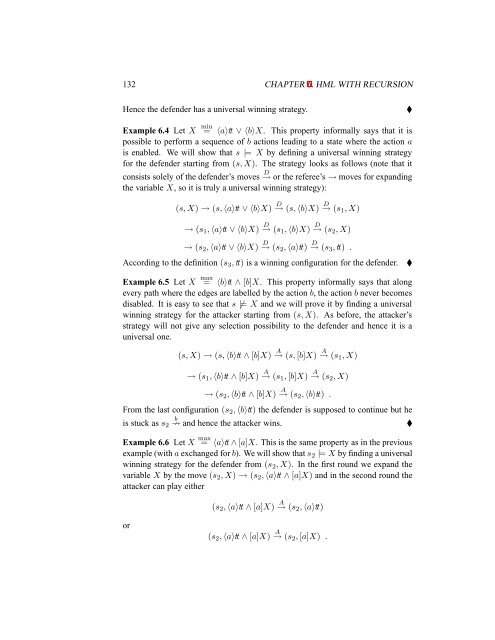Reactive Systems: Modelling, Specification and Verification - Cs.ioc.ee
Reactive Systems: Modelling, Specification and Verification - Cs.ioc.ee
Reactive Systems: Modelling, Specification and Verification - Cs.ioc.ee
Create successful ePaper yourself
Turn your PDF publications into a flip-book with our unique Google optimized e-Paper software.
132 CHAPTER 6. HML WITH RECURSION<br />
Hence the defender has a universal winning strategy. <br />
Example 6.4 Let X min<br />
= 〈a〉tt ∨ 〈b〉X. This property informally says that it is<br />
possible to perform a sequence of b actions leading to a state where the action a<br />
is enabled. We will show that s |= X by defining a universal winning strategy<br />
for the defender starting from (s, X). The strategy looks as follows (note that it<br />
consists solely of the defender’s moves D → or the refer<strong>ee</strong>’s → moves for exp<strong>and</strong>ing<br />
the variable X, so it is truly a universal winning strategy):<br />
(s, X) → (s, 〈a〉tt ∨ 〈b〉X) D → (s, 〈b〉X) D → (s1, X)<br />
→ (s1, 〈a〉tt ∨ 〈b〉X) D → (s1, 〈b〉X) D → (s2, X)<br />
→ (s2, 〈a〉tt ∨ 〈b〉X) D → (s2, 〈a〉tt) D → (s3, tt) .<br />
According to the definition (s3, tt) is a winning configuration for the defender. <br />
Example 6.5 Let X max<br />
= 〈b〉tt ∧ [b]X. This property informally says that along<br />
every path where the edges are labelled by the action b, the action b never becomes<br />
disabled. It is easy to s<strong>ee</strong> that s |= X <strong>and</strong> we will prove it by finding a universal<br />
winning strategy for the attacker starting from (s, X). As before, the attacker’s<br />
strategy will not give any selection possibility to the defender <strong>and</strong> hence it is a<br />
universal one.<br />
(s, X) → (s, 〈b〉tt ∧ [b]X) A → (s, [b]X) A → (s1, X)<br />
→ (s1, 〈b〉tt ∧ [b]X) A → (s1, [b]X) A → (s2, X)<br />
→ (s2, 〈b〉tt ∧ [b]X) A → (s2, 〈b〉tt) .<br />
From the last configuration (s2, 〈b〉tt) the defender is supposed to continue but he<br />
is stuck as s2 b <strong>and</strong> hence the attacker wins. <br />
Example 6.6 Let X max<br />
= 〈a〉tt ∧ [a]X. This is the same property as in the previous<br />
example (with a exchanged for b). We will show that s2 |= X by finding a universal<br />
winning strategy for the defender from (s2, X). In the first round we exp<strong>and</strong> the<br />
variable X by the move (s2, X) → (s2, 〈a〉tt ∧ [a]X) <strong>and</strong> in the second round the<br />
attacker can play either<br />
or<br />
(s2, 〈a〉tt ∧ [a]X) A → (s2, 〈a〉tt)<br />
(s2, 〈a〉tt ∧ [a]X) A → (s2, [a]X) .
















